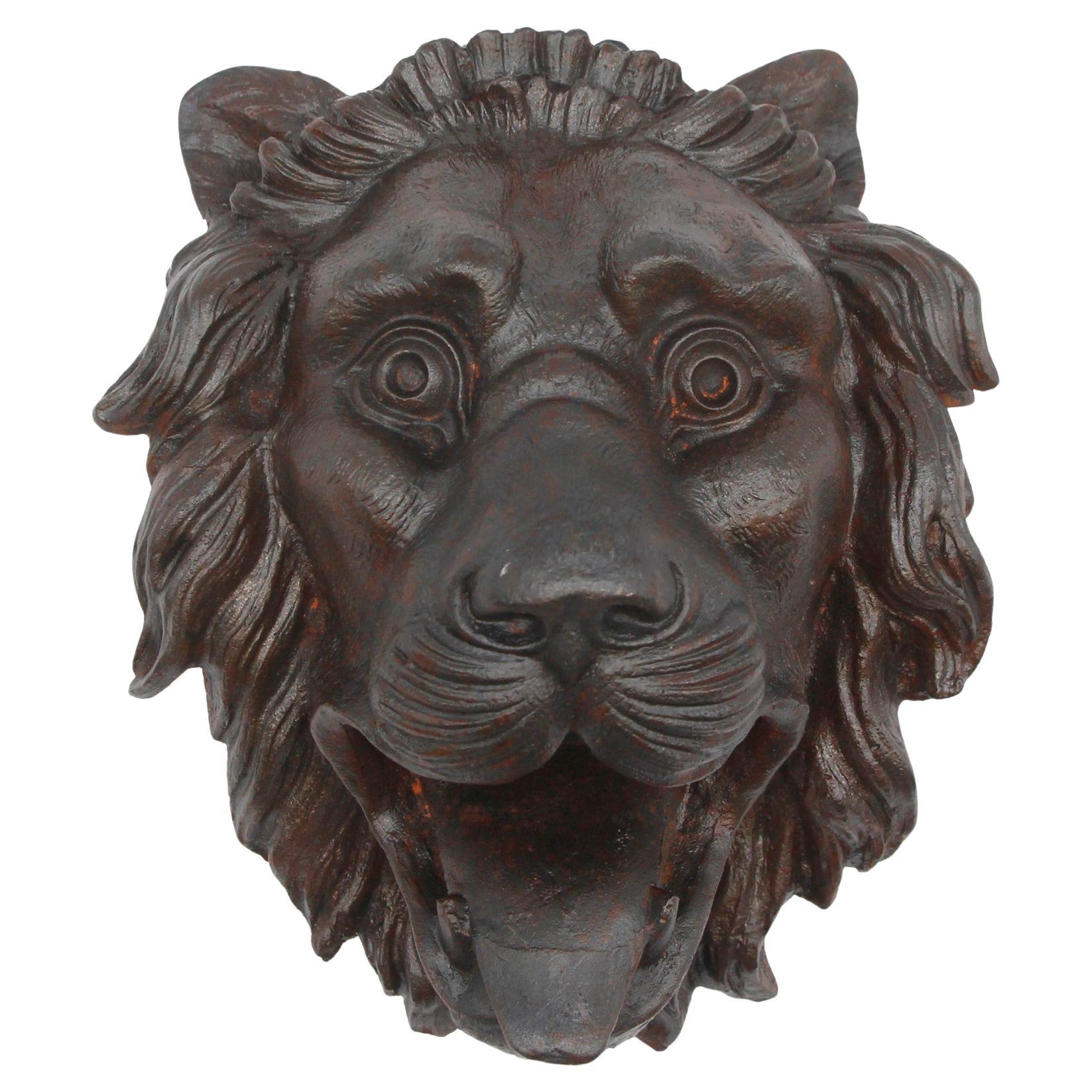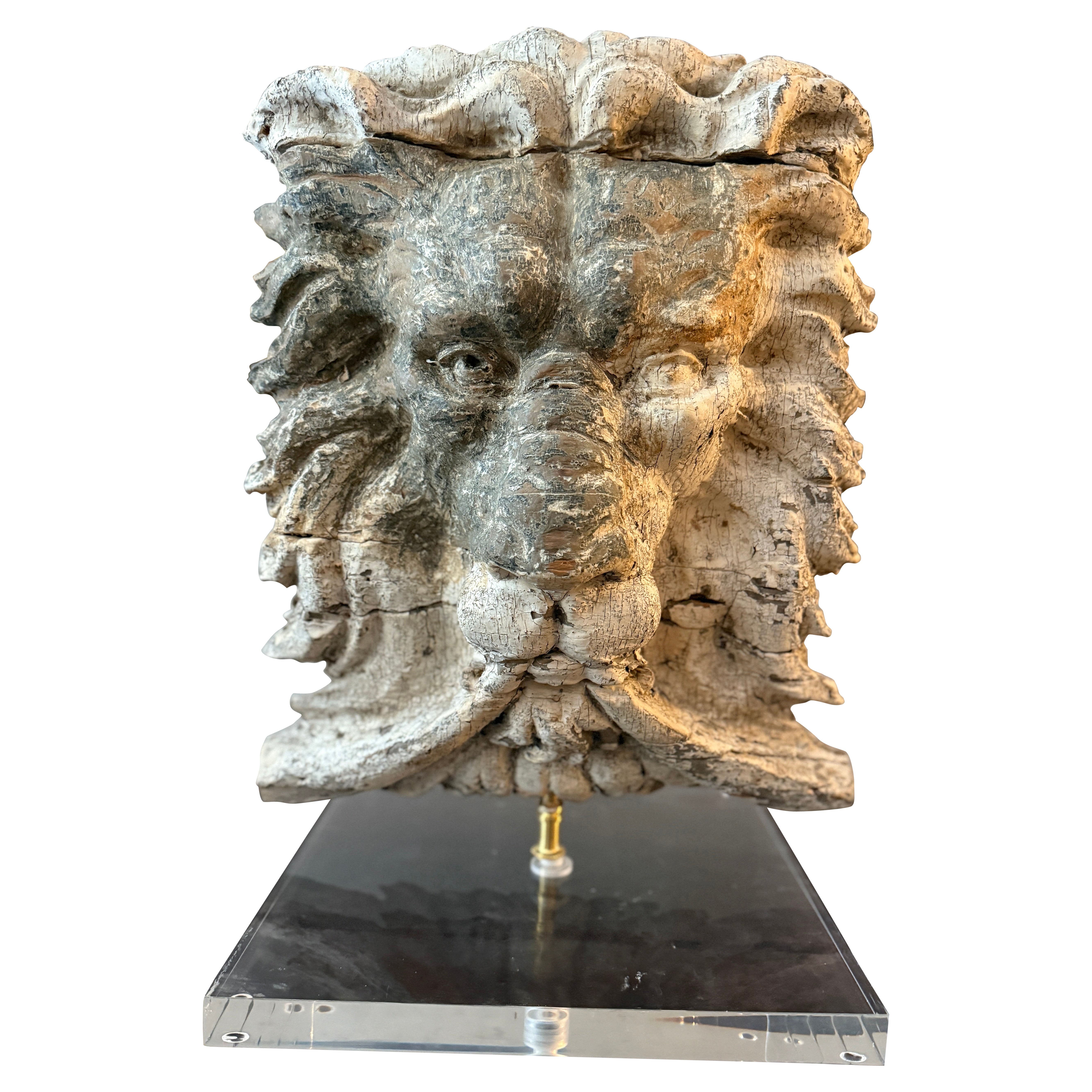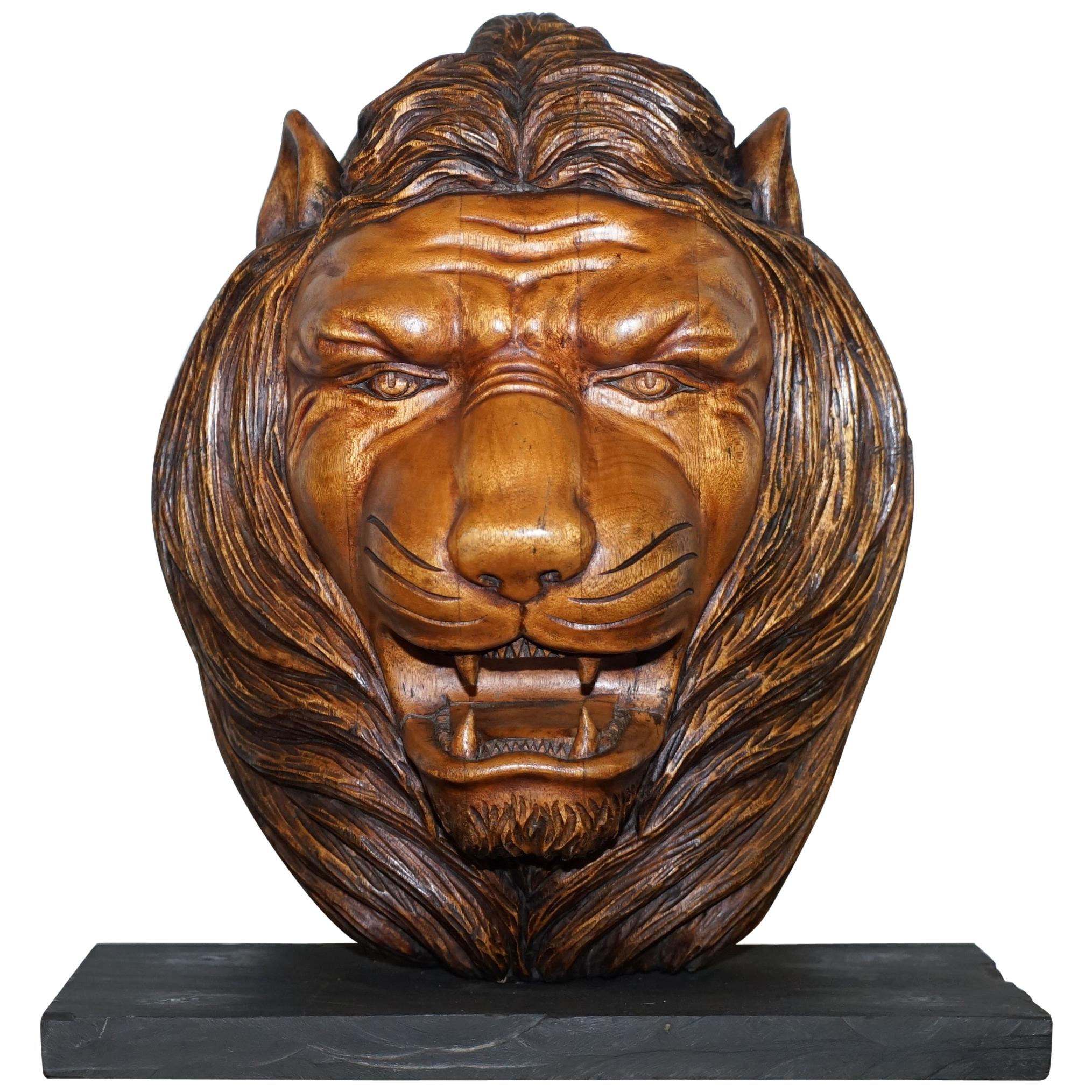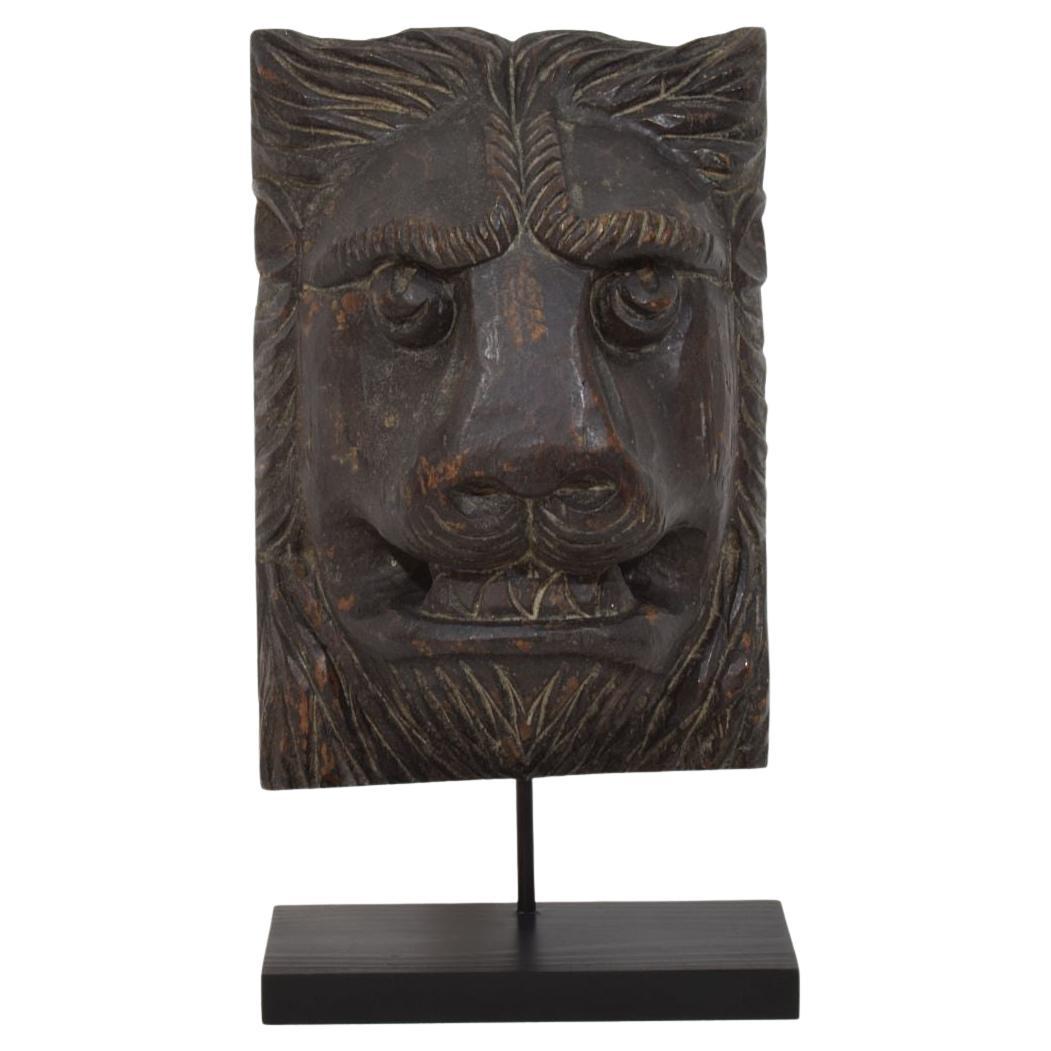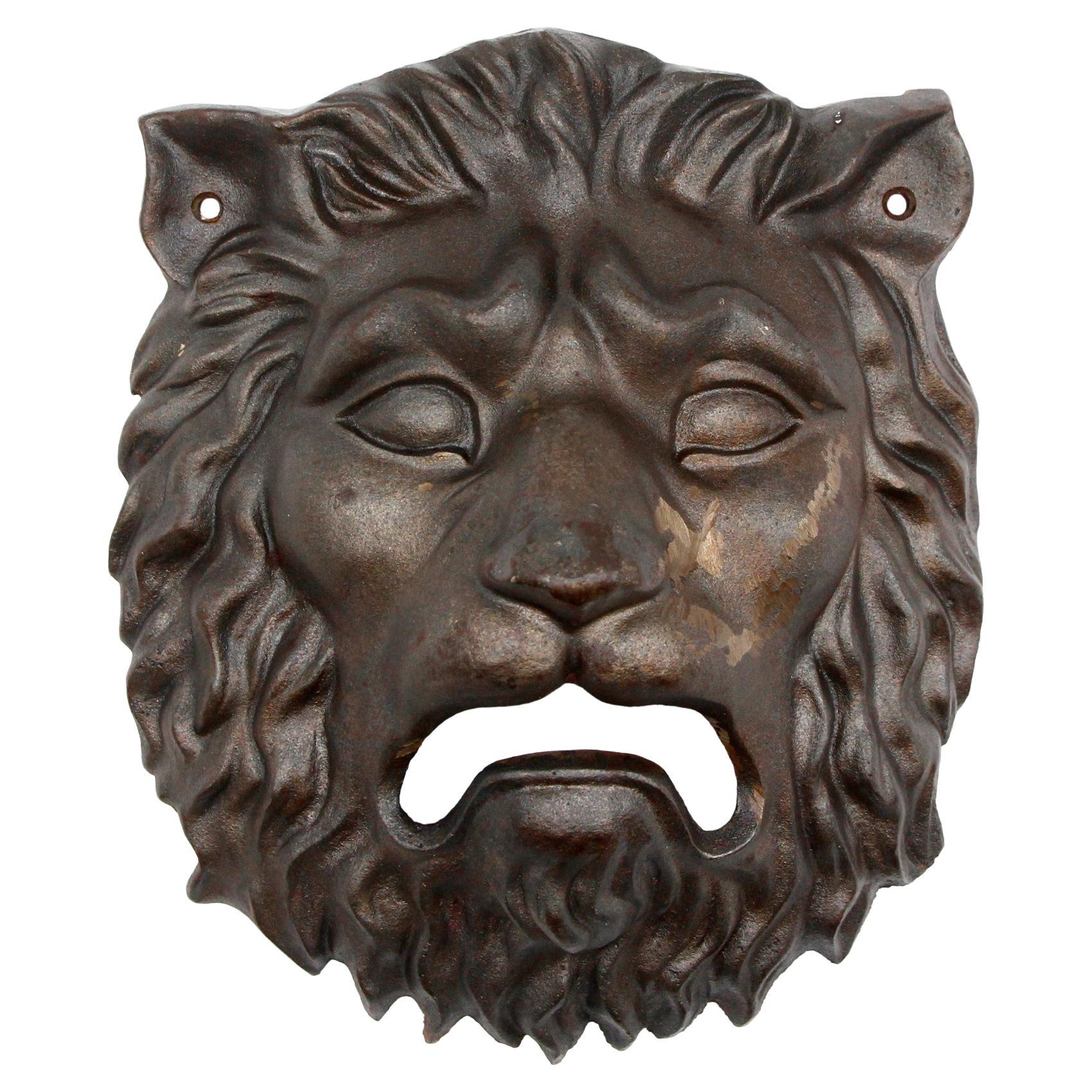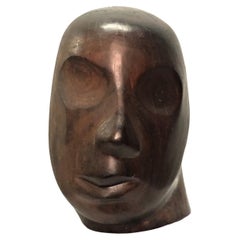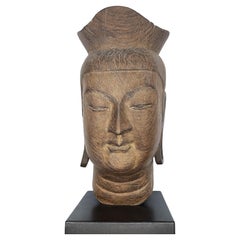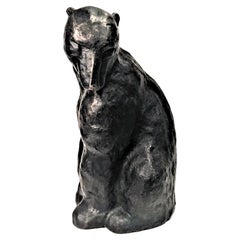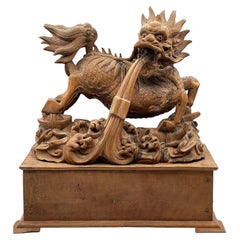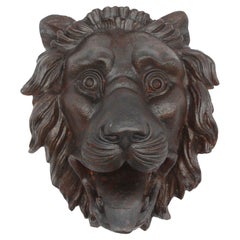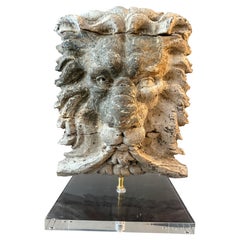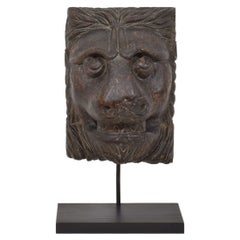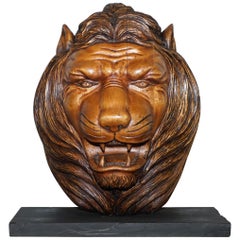Items Similar to Antique Carved Wood Lion’s Head from a Manhattan Bar, ca. 1880s-1890s
Want more images or videos?
Request additional images or videos from the seller
1 of 7
Antique Carved Wood Lion’s Head from a Manhattan Bar, ca. 1880s-1890s
$4,800
£3,644.08
€4,168.05
CA$6,706.30
A$7,458.87
CHF 3,894.79
MX$90,766.45
NOK 49,742.38
SEK 46,649.58
DKK 31,107.74
Shipping
Retrieving quote...The 1stDibs Promise:
Authenticity Guarantee,
Money-Back Guarantee,
24-Hour Cancellation
About the Item
Dimension:
Height: 14 inches
Width: 13 inches
Depth: 12 inches.
About the object:
This elaborately carved wood lion's head was an integral decorative piece of a bar counter or shelf unit in a Manhattan bar, and dates from around the 1880s. Since electricity was one of the main and newfangled inventions of that time, the small electric bulbs embedded in the lion's eyes are especially noteworthy.
- Dimensions:Height: 14 in (35.56 cm)Width: 13 in (33.02 cm)Depth: 12 in (30.48 cm)
- Style:American Classical (Of the Period)
- Materials and Techniques:
- Place of Origin:
- Period:
- Date of Manufacture:circa 1880s-1890s
- Condition:Wear consistent with age and use. We make our best effort to provide a fair and descriptive condition report. Please examine photos attentively, as they are an integral part of the description. Send us a message to request more details or discuss price.
- Seller Location:New York, NY
- Reference Number:1stDibs: LU2819330233082
About the Seller
5.0
Vetted Professional Seller
Every seller passes strict standards for authenticity and reliability
Established in 1993
1stDibs seller since 2017
83 sales on 1stDibs
Typical response time: 7 hours
- ShippingRetrieving quote...Shipping from: New York, NY
- Return Policy
Authenticity Guarantee
In the unlikely event there’s an issue with an item’s authenticity, contact us within 1 year for a full refund. DetailsMoney-Back Guarantee
If your item is not as described, is damaged in transit, or does not arrive, contact us within 7 days for a full refund. Details24-Hour Cancellation
You have a 24-hour grace period in which to reconsider your purchase, with no questions asked.Vetted Professional Sellers
Our world-class sellers must adhere to strict standards for service and quality, maintaining the integrity of our listings.Price-Match Guarantee
If you find that a seller listed the same item for a lower price elsewhere, we’ll match it.Trusted Global Delivery
Our best-in-class carrier network provides specialized shipping options worldwide, including custom delivery.More From This Seller
View AllHead, French Modernist Hand-Carved Wood Sculpture, ca. 1950
Located in New York, NY
Unusual in its conciseness and modernistic vision of a rather familiar subject - the human head - this original elegant sculpture does not leave anyone indifferent and is imprinted i...
Category
Vintage 1950s French Mid-Century Modern Abstract Sculptures
Materials
Wood
Japanese Late Meiji Period Head of Buddha in Wood, Ca. 1910
Located in New York, NY
Japanese Late Meiji Period Head of Buddha in Wood, Ca. 1910
DIMENSIONS:
Height: 22 inches
Width: 7 inches
Depth: 7 inches
ABOUT
A serene and finely carved wooden Head of Buddha fro...
Category
Vintage 1910s Japanese Japonisme Busts
Materials
Wood
French Antique Bronze Sculpture of She-Bear, Early XX Century
Located in New York, NY
This exquisite French animalistic bronze sculpture from the early twentieth century is beautiful in every way - its artistic expressiveness, as well as the highest-level rendition, h...
Category
Early 20th Century French Art Nouveau Animal Sculptures
Materials
Bronze
Japanese Edo Period Okimono Carving of a Mythological Figure of Kirin, Ca. 1860
Located in New York, NY
Japanese Edo Period Okimono Carving of a Mythological Figure of Kirin, Ca. 1860
(Edo Period 1603-1868) 19th Century
DIMENSIONS:
Height: 13 i...
Category
Antique 1860s Japanese Figurative Sculptures
Materials
Wood
Alexander Ney, Head, Gilt Terracotta Sculpture, circa 1990
By Alexander Ney
Located in New York, NY
Gilt terracotta sculpture on marble base.
Signed with artist's facsimile, dated '90
Alexander Ney (Russian, born in 1939 in Leningrad, Russia) is an American sculptor and painter...
Category
1990s American Modern Busts
Materials
Marble
Ernst Seger, David and Lion, German Art Deco Patinated Bronze Sculpture, c. 1920
By Ernst Seger
Located in New York, NY
Signed “E. Seger”.
Black patina.
Dimensions
Height: 8 inches (20cm)
Width: 7.5 inches (18.75cm)
Depth: 8.5 inches (21.25cm)
THE BIBLE STORY
Samuel 17:34-36
Originally, Saul would not allow David to fight Goliath (17:33). Saul’s reason was simply that Goliath would be stronger than David. David was young and he did not have the experience to fight such a capable enemy as Goliath. David was likely to die, and his death would benefit nobody.
Often people wrongly imagine that they are acting in faith (in other words, that they are trusting God). Really, they are acting in a foolish manner, as if the danger is not real. They are not trusting in God, but in their own thoughts, hopes and desires.
David’s reply to Saul shows us his attitudes. This reply explains clearly why David had offered to fight Goliath. In other words, it shows how David considered himself able to defeat Goliath.
Like many boys and young men in Israel, David had worked as a shepherd. That is, he looked after sheep. He was responsible to look after those sheep in every way. In particular, he had to protect them from wild animals.
Lions and bears are some of the fiercest large wild animals. They were common in Israel at the time of the Bible. They are much stronger than a man (see for example 1 Kings 13:24 and 2 Kings 2:24). Only the bravest and strongest men were able to kill a lion (Judges 14:5-6; 2 Samuel 23:20). However, David had killed both a lion and a bear. He had killed animals that were stronger than him.
David did not believe that the strongest man would win the fight. David had a close relationship with God; he was trusting God to rescue him (17:37). David was not pretending that there was no danger. However, God’s Holy Spirit was active in David’s life (16:13). By the power of his Holy Spirit, God had given David the faith (trust in God) to fight Goliath. Because David really was trusting God, there was no reason for him to be afraid of Goliath.
THE ARTIST
Ernst Seger (1865 1939), born in Neurode (Nowa Ruda, now Poland), studied sculpturing from 1884 at the Kunstschule in Breslau under Robert Härtel. From 1886 he worked in the Atelier of Christian Behrens, where he created the Eichendorff-Memorial for the Silezian City of Neisse. From 1893 to 1894 Seger stayed in Paris where he worked in the atelier of Auguste Rodin. However, Seger finally chose a ‘Jugenstill’ and a more ‘naturalistic’ or ‘Neuklassizismus’ style. His sculptures, modelled like the Greek antiques, were later greatly admired by the National Socialists.
At the end of 1894 Ernst Seger went back to Berlin, founded his own atelier and created the Kaiser Wilhelm I memorial for the Silesian City of Glatz. In 1897 Seger created the sculpture ‘Jugend’ (‘Youth’), which was displayed at the ‘Große Berliner Kunstausstellung’ in 1898, at the ‘Große Berliner Kunstausstellung’ in 1899, at the ‘Münchener Glaspalast Ausstellung’ in 1899 and at the ‘Münchener Glaspalast Ausstellung’ in 1908. As a sculptor Seger regarded this as his first relevant work, his breakthrough. A copy of the sculpture in bronze, 1.60 metres high, was placed in the ‘Scheitniger Park’ in Breslau (now Wroclaw). In 1898 Segers ‘Diana’, the Roman Goddess of the Hunt, the Moon and Childbirth, was unvealed in Park Szczytnicki, Breslau, Polen (earlier ‘Schneitniger Park’). Until 1945 the sculpture stayed in the Schneitniger Park, Breslau. This part of the park is still called ’Dianagarten’.
After the turn of the century the elegant female dancers and nudes by Seger gained great popularity. In 1905 Ernst Seger created -together with the sculptor Bernhard Sehring- the ‘Bismarck Brunnen’ (‘Bismarck Fountain’) in Breslau. This memorial-fountain (which still exists) represents the allegories ‘Kampf’ and ‘Sieg’ (‘Battle and Victory’). Seger’s ‘Verwundete Amazone’ (‘Wounded Amazon’), displayed at the Grosse Münchner Kunstausstellung in the Glaspalast in 1908, was placed in the garden of the ‘Kaufhauses Wertheim’ in Berlin. In the same year he was appointed as a professor. Seger’s marble sculpture ‘Kypris’, created in 1916, was placed in the Alten Nationalgalerie in Berlin. In 1925 the City of Berlin acquired his sculpture ‘Anbetung’ and placed it at the Johannaplatz. ‘Storchenbrunnen’ (‘Stork-fountain’), was placed in 1931 at the Adolf-Scheidt-Platz in Berlin. In 1935 the American newspaper publisher William Randolph Hearst bought Seger’s sleeping ‘Ganymede’.
During the Third Reich Ernst Seger was commissioned numerous Hitler busts...
Category
Vintage 1920s German Art Deco Figurative Sculptures
Materials
Bronze
You May Also Like
Late 1800s, Heavy Ornate 3D Black Cast Iron Lion Head
Located in New York, NY
Late 1800s heavy solid cast iron lion head with ornate detail. Slightly concave side profile. Please note, this item is located in one of our NYC l...
Category
Antique 19th Century American Animal Sculptures
Materials
Iron
19th-Century Carved Pine Lion’s Head Architectural Fragment, Mounted on Lucite
Located in Atlanta, GA
A substantial and finely carved wooden lion’s head, likely originating from a 19th-century architectural setting, such as a grand entryway, theater, or public building. This striking...
Category
Antique 19th Century American Baroque Mounted Objects
Materials
Lucite, Pine
17th/18th Century French Carved Wooden Lion Head
Located in Buisson, FR
Gorgeous hand-carved wooden lion head with a great patina due to its extreme high age.
France circa 1650-1750
Weathered. measurements include the wooden base.
H:32,5cm W:18,5cm D:1...
Category
Antique 17th Century French Rustic Architectural Elements
Materials
Wood
$593 Sale Price
50% Off
Large Rare Hand Carved Lions Mane Bust Head in Wood with Solid Marble Base
Located in West Sussex, Pulborough
We are delighted to offer for sale this stunning very large and decorative solid wood hand carved Lion's mane mounted to a marble base
A very good looking well made and decorative...
Category
20th Century English Modern Animal Sculptures
Materials
Marble
$1,774 Sale Price
30% Off
17th/18th Century French Carved Wooden Lion Head
Located in Buisson, FR
Gorgeous hand-carved wooden lion head with a great patina due to its extreme high age.
France circa 1650-1750
Weathered. measurements include the wooden base.
H:31cm W:17cm D:12cm
Category
Antique 17th Century French Rustic Architectural Elements
Materials
Wood
$593 Sale Price
50% Off
Early 20th C Black Cast Iron Roaring Lion Head Wall Mount
Located in New York, NY
Early 20th century detailed lion head with an open roaring mouth. Antique cast iron. Please note, this item is located in one of our NYC locations.
Category
Early 20th Century American Animal Sculptures
Materials
Iron
More Ways To Browse
Bar Counters
Carved Wood Lions
Carved Lion Head
Lion Head Wood Furniture
Antique Wood Carved Lion
Used Office Furniture Manhattan
Antique Wood Counter
Electric Bar
Carved Wood Animal Heads
Lion Shelf
Antique Bar Counter
Metal Lion Head
Solid Brass Animal
Mexican Mixed Metal
Vintage Brass Bird
Mcm Sculpture
Porcelain Bird Sculpture
Vintage Murano Birds
